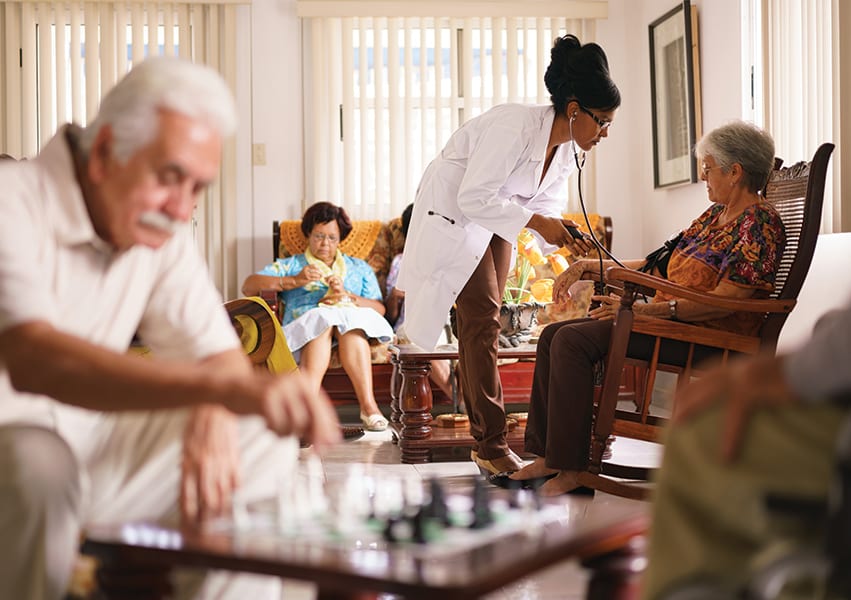When looking at assisted living communities for yourself or a loved one, you’ve probably come across the phrase “assisted living levels of care” when reviewing the types of services provided by different senior living communities.
But what, exactly, does “assisted living levels of care” mean?
Assisted living “levels of care” generally refers to how much assistance a person needs with activities of daily living (ADLs) as well as management of one’s health.
- Activities of Daily Living (ADLs) encompass essential tasks necessary for one’s everyday functioning. Activities of daily living examples include tasks like getting dressed, taking a bath or shower, eating and using the restroom.
- Medical needs may depend on whether the individual can take prescription medications or manage chronic conditions independently, or whether some assistance from a caregiver is needed.
Assisted living levels of care are often determined by an individual’s ability to perform Activities of Daily Living (ADLs) and their medical needs. As one’s health condition and functional abilities change, so do their requirements for care. For individuals who can independently manage their ADLs, a lower level of care may suffice. However, those with more complex medical needs or diminished ADL capabilities might require higher levels of care, like retirement homes, skilled assisted living facilities, or full-time caregiving. This dynamic relationship between medical needs and ADLs plays a crucial role in tailoring healthcare services to match an individual’s unique circumstances and ensure they receive the appropriate level of support and assistance.
Let’s take a look at some of the factors that determine the level of care you or your loved one may need, which will help determine the best assisted living facility or other senior living community for your needs.
Assisted Living Levels of Care by Individual Activity
Each assisted living resident is unique and will require a different amount of assistance. You can use the following activities of daily living checklist to assess whether the resident needs help with any of the following, and the amount and type of help required.
- Bathing. Some residents simply need a reminder to take a bath or shower at the right time. Others may be able to bathe themselves, but need someone nearby if they are at risk of falling. Still others may need one or more caregivers to help with bathing.
- Dressing. Residents may require different levels of help with getting dressed. One resident may be able to put clothes on but lack the manual dexterity to fasten buttons and zippers. Another may need help choosing the right clothes to wear depending on the occasion or weather conditions.
- Grooming. This includes activities like brushing teeth, fixing one’s hair and shaving. If a resident lacks range of motion in his or her shoulders, for example, hair brushing may be difficult and require the help of a caregiver.
- Mobility. This includes walking, the ability to use mobility aids, and the ability to transfer or stand. In some cases a resident who can use a wheelchair or cane independently may actually need less care than another resident who needs assistance with standing or walking.
- Incontinence. This includes the ability to manage the condition independently — such as changing protective underwear without assistance. Residents who require help from a caregiver are classified as needing a higher level of care.
- Eating. Some individuals can feed themselves but need help cutting their food. Some individuals may be at risk of choking and require the presence of a caregiver as a safety precaution. Those with limited upper body function may need a caregiver to help with feeding.
- Medication. Is the resident able to fill and take medications without help? Some residents may have trouble opening pill bottles or self-administering injections. Others may be able to take medications independently but rely on daily reminders to make sure they are getting the correct dosage and taking prescriptions at the right times.
- How many caregivers are needed? The resident who only needs help with one ADL is classified as needing fewer caregivers and a lower level of care, while those with multiple impairments will want to choose a facility that offers a higher level of care from a team of caregivers.
Overall Level of Care Needed
After reviewing individual ADLs and medical requirements, you can assess the resident’s overall level of care needs.
- Level One — Low level of care. This resident is mostly independent living but may need reminders to perform ADLs. Some may require a low level of supervision or assistance to ensure that tasks are performed correctly and safely.
- Level Two — Intermediate or moderate level of care. The resident may be independent with some ADLs, such as feeding oneself, but need help with others, such as getting dressed.
- Level Three — High level of care. This individual has impairments that affect multiple ADLs and requires a comprehensive level of assistance from multiple caregivers.
Do you have questions about the assisted living levels of care you or a loved one needs to enjoy the quality of life we all deserve? Are you looking for an assisted living facility that offers the appropriate level of care for your needs?
Talk to us at Culpepper Place. We’ll provide information about the amenities and services provided by caring staff members at our assisted living community in Olive Branch, MS.






